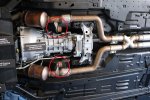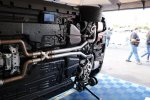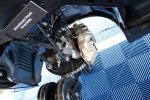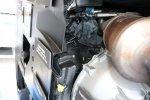Voodoo Parts
- Thread starter djs
- Start date
You are using an out of date browser. It may not display this or other websites correctly.
You should upgrade or use an alternative browser.
You should upgrade or use an alternative browser.
As this article states, the Voodoo block and heads are now offered as replacement parts.
However, Ford strategically has not offered the FPC for purchase over the counter, nor have they elected to sell the 5.2 as a crate engine.
You have to ask yourself, why is this so?:confused
For those who understand engine dynamics indigenous with a flat plane crankshaft it is easy to understand. This engine with it's associated vibration characteristics is NOT a plug-n-play type engine. The Mustang with the 5.2 engine was designed as a complete SYSTEM and you cannot just remove the engine and plug it into another car without some serious engineering consideration. I am sure some will try. It will be interesting to see the outcome, if the experimenters are open and honest about their trials.
However, Ford strategically has not offered the FPC for purchase over the counter, nor have they elected to sell the 5.2 as a crate engine.
You have to ask yourself, why is this so?:confused
For those who understand engine dynamics indigenous with a flat plane crankshaft it is easy to understand. This engine with it's associated vibration characteristics is NOT a plug-n-play type engine. The Mustang with the 5.2 engine was designed as a complete SYSTEM and you cannot just remove the engine and plug it into another car without some serious engineering consideration. I am sure some will try. It will be interesting to see the outcome, if the experimenters are open and honest about their trials.
I would have thought that the only reason it is not over the counter - yet, is due to the production car demand. While I agree it is a complete system - and definitely unique in the American muscle car world, I would suspect that the engineering to overcome the unique balancing requirements were achieved internally - with the exception perhaps being specialized attention to the harmonic balancer and flywheel weighting & characteristics. Pull these components across too and I suspect that you would have a pretty complete transferable package. No?
Bill the R&T article shortened the actual article from SVTP. Toward the end suggests some reasons and applications that might shed some light. Like the bigger valved heads on a 5.0 Coyote, or building a 5.2 Coyote cross plane, but the base is the voodoo block and heads.
http://www.svtperformance.com/2015/11/30/new-products-gt350-5-2-liter-engine-parts/
http://www.svtperformance.com/2015/11/30/new-products-gt350-5-2-liter-engine-parts/
Bill the R&T article shortened the actual article from SVTP. Toward the end suggests some reasons and applications that might shed some light. Like the bigger valved heads on a 5.0 Coyote, or building a 5.2 Coyote cross plane, but the base is the voodoo block and heads.
Andy, not quite sure what you are saying here. I am doing some additional fact checking before addressing Kendall's comment. More to come.
But it is interesting in the link you posted for the svt performance article. It states " While the flat-plane crankshaft will not be available from Ford Performance Parts (nor will the Voodoo 5.2 be available as a crate engine), the 5.0-liter Coyote Mustang Boss 302 Forged Crankshaft (PN M-6303-M50B; $429) will bolt right in if you want to construct a big-bore, cross-plane powerplant." I had not seen this stated as such directly from Ford but confirms my belief and opinion in the earlier post this engine is not viewed as a "replacement" engine for some other vehicle. Use of the FPC needs to be engineered as a total system.
Seems clear Ford will enable an engine builder to assembly a 5.2L "big bore" Coyote engine but you will be required to use the cross plane crankshaft. You will still get the 5.2 displacement because there was not a stroke change between the two crankshafts, and believe because of the increased bore one will need to use the specific 5.2 heads with this block.
Your GT350 underside picture is in fact very telling. Some of the additional damping system(s) used to dampen harmonics. Believe this picture in itself goes to answer Kendall's question that there are other damping systems employed on the 5.2 equipped vehicles which ARE external to the engine. Interesting the "talkie" posters placed around specific underside features do not point this out or call attention to this feature, but it is clearly an auxiliary damping system.
Last edited:
I would have thought that the only reason it is not over the counter - yet, is due to the production car demand.
Nope, I believe (and this is my opinion) it is highly unlikely, the key Flat Plane Crank (FPC) will be released as a standalone part because of the engine dynamics issue. Notice in the svtperformance article Andy posted above, Ford offers the large bore Coyote block (5.2) and offers the correct heads for this block, but recommends the builder go use/buy the cross-plane crankshaft. Thus you can build a semi-VooDoo engine, except it will not sound like the Ford production engine because you must use the current 5.0 cross-plane crank.
While I agree it is a complete system - and definitely unique in the American muscle car world, I would suspect that the engineering to overcome the unique balancing requirements were achieved internally - with the exception perhaps being specialized attention to the harmonic balancer and flywheel weighting & characteristics. Pull these components across too and I suspect that you would have a pretty complete transferable package. No?
Again, Nope. I would take slight exception to the use of your term “internally” as to engine balance. Internally does usually mean within the confines of the engine block and most engine rotating components are internally balanced. However, engine builders have balanced engine reciprocating components outside the engine block through specific engine harmonic dampers and possibly unique flywheels. The Chevy 400 Cubic Inch Displacement (CID) “small block” engine comes to mind.
This goes back a ways for me but I believe stretching the internal cubic inches through bore/stroke modifications to get the 400 CID within the physical outside limits of the small block casting did not leave enough internal room for the correct crank counterweight masses. The engineers simply did not have adequate room. And so the designers were forced to “externally” balance this engine with a unique harmonic damper. But (and this is important) you COULD take a 400 CID Chevy small block and drop it into another vehicle because the engine (as an entity) was balanced. This is just simply not the case with the FPC 5.2 engine which relies on vehicle damping to tame the vibration characteristics developed by the FPC. The engine needs the vehicle to support acceptable Noise/Vibration/Harshness (NVH) characteristics. Bringing us back to the GT350 powerplant system was designed specifically with this model Mustang.
twobjshelbys
GT Owner
Believe this picture in itself goes to answer Kendall's question that there are other damping systems employed on the 5.2 equipped vehicles which ARE external to the engine. Interesting the "talkie" posters placed around specific underside features do not point this out or call attention to this feature, but it is clearly an auxiliary damping system.
And a lot further downstream than I expected them to be.
Also isnt there more than just engine balancing, like these on the exhaust?
Note also the huge harmonic weight just in front of the transmission crossmember. There is some serious shake, rattle and roll going on there.
Good eyes Tony and Paul. Just goes to reinforce the concept that this engine/vehicle combination was designed as a complete system.
Track users are to be cautioned not to remove these seemingly useless weights "randomly" attached at various locations around the car. (Like the big weight on our transaxle shift linkage in the FGT). Fight the temptation to remove these masses in the quest of lowered vehicle weight because they are very necessary and strategically/purposefully placed on the vehicle for a specific reason. Trust the Ford design team on this issue.
Track users are to be cautioned not to remove these seemingly useless weights "randomly" attached at various locations around the car. (Like the big weight on our transaxle shift linkage in the FGT). Fight the temptation to remove these masses in the quest of lowered vehicle weight because they are very necessary and strategically/purposefully placed on the vehicle for a specific reason. Trust the Ford design team on this issue.
Last edited:
twobjshelbys
GT Owner
Good eyes Tony and Paul. Just goes to reinforce the concept that this engine/vehicle combination was designed as a complete system.
Track users are to be cautioned not to remove these seemingly useless weights "randomly" attached at various locations around the car. (Like the big weight on our transaxle shift linkage in the FGT). Fight the temptation to remove these masses in the quest of lowered vehicle weight because they are very necessary and strategically/purposefully placed on the vehicle for a specific reason. Trust the Ford design team on this issue.
Those are going to put some serious burden on the aftermarket exhaust guys too.
I would say correct again. I would be hesitant to substitute a different exhaust system which does not have this damping provision. Heck the engine sounds pretty good in OE form!
It would appear these dampers attenuate engine roll about the crankshaft centerline. Probably more effective if the dampers could have been placed farther forward to diminish spring rate effects from the forward exhaust pipes, but higher exhaust pipe temperatures and packaging constrains probably dictated the final location.
It would appear these dampers attenuate engine roll about the crankshaft centerline. Probably more effective if the dampers could have been placed farther forward to diminish spring rate effects from the forward exhaust pipes, but higher exhaust pipe temperatures and packaging constrains probably dictated the final location.
I was trying to point out, that the shorter R&T article, could make one ask, what on earth would you do with these parts with out the crank? I before seeing the SVTP article, didn't know the 5.0 and 5.2 were that similar with interchangeable parts (maybe a key detail that I just missed) The longer SVT article gets into how the heads will bolt on a "normal" 5.0 (while not fully exploiting their advantages), and the 5.2 block can also be build cross plane.
Andy, not quite sure what you are saying here.
Thanks for the clarification Andy. I see what you were saying.
Great underside pictures! And good detail observations.
Great underside pictures! And good detail observations.
twobjshelbys
GT Owner
Thanks for the clarification Andy. I see what you were saying.
Great underside pictures! And good detail observations.
But I don't think you get a drop in when you take the new block, heads and 5.0 crank. You still need the ECU programming since the 5.0 will probably not work. So wile it's possible to build a 5.2 Coyote, it's not easy.
It would probably not be emissions compliant either.
Last edited:
Agree with both.
Possible but not easy.
As several sage technical experts read these posts and nudge me in the correct direction when my wheels head off the tarmac, I must correct my earlier statement that both the cross plane crank and FPC have identical strokes. They do not.
The cross plane Boss 5.0L crank has a stroke of 92.7 mm.
The GT350 flat plane 5.2L crank has a stroke of 93.0 mm.
Upshot of building a large bore Roadrunner engine with the Boss crank is a slight reduction in engine displacement (due to the 0.3 mm shorter stroke) and a corresponding slight reduction in compression ratio.
Possible but not easy.
As several sage technical experts read these posts and nudge me in the correct direction when my wheels head off the tarmac, I must correct my earlier statement that both the cross plane crank and FPC have identical strokes. They do not.
The cross plane Boss 5.0L crank has a stroke of 92.7 mm.
The GT350 flat plane 5.2L crank has a stroke of 93.0 mm.
Upshot of building a large bore Roadrunner engine with the Boss crank is a slight reduction in engine displacement (due to the 0.3 mm shorter stroke) and a corresponding slight reduction in compression ratio.
Last edited:
Here goes the mid pipe....
http://www.svtperformance.com/forum...thal-Performance-GT350-GT350R-Offroad-Midpipe
http://www.svtperformance.com/forum...thal-Performance-GT350-GT350R-Offroad-Midpipe
Agree with both.
Possible but not easy.
As several sage technical experts read these posts and nudge me in the correct direction when my wheels head off the tarmac, I must correct my earlier statement that both the cross plane crank and FPC have identical strokes. They do not.
The cross plane Boss 5.0L crank has a stroke of 92.7 mm.
The GT350 flat plane 5.2L crank has a stroke of 93.0 mm.
Upshot of building a large bore Roadrunner engine with the Boss crank is a slight reduction in engine displacement (due to the 0.3 mm shorter stroke) and a corresponding slight reduction in compression ratio.
You guys are just way too ahead of the game. With just a block and heads available so far, there's a bit of an open door in the parts bin.
Surely, some enterprising outfit (if not Ford) will come up with the revised (lightweight) pistons, camshafts and an (high speed processor) ECU that will enable the engine to surpass the FPC variant. ;-))





